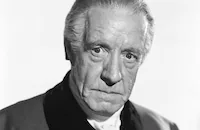The Thirteenth Chair

Brief Synopsis
Cast & Crew
George B. Seitz
Dame May Whitty
Madge Evans
Lewis Stone
Elissa Landi
Thomas Beck
Film Details
Technical Specs

Synopsis
In Calcutta, India, Inspector Marney has just arrived from Scotland Yard to investigate the death of Englishman Leonard Leith, who was stabbed in his bungalow, and whose body has already been cremated. In the bungalow, Marney meets John Wales, Lee's closest friend, who reveals that because Leith had high connections in the government, police Commissioner Grimshaw cannot place pressure on the suspects. Wales suggests a plan whereby a seance will be held by local medium Mme. Rosalie La Grange, to determine the murderer, and the provincial governor, Sir Roscoe Crosby, agrees to the plan. Wales invites several of the suspects, as well as other people "beyond suspicion," including Sir Roscoe's son Dick, who is in love with Nell O'Neill, his mother's secretary. Soon after the guests arrive, Mme. La Grange enters and says that she detects a spirit called "Laughing Eyes," then laughs and promises that she only uses such dramatic trickery for fun. She then swears that tonight there will be no tricks; if they get a message, it will be true. During a search to look for hidden microphones, Mme. La Grange surreptitiously tells Nell that they must keep quiet. As the seance begins, some guests worry that there are exactly thirteen people at the table. During the seance, "Laughing Eyes" speaks, and Wales asks who killed Lee, then Wales suddenly stops speaking. When the lights go on, Wales is dead, and Inspector Marney is summoned. His investigation reveals that the circle was unbroken, Mme. La Grange was tied to her chair and the doors had been locked shut. He asks the guests to reoccupy their places during the seance and says that everyone will be searched for the knife that killed Wales. Marney then talks to Mme. La Grange and asks her what name John had asked her to reveal. While she is being questioned, Nell interrupts and reveals that Mme. La Grange is her mother. After everyone is searched, Lionel Trent reveals to his wife Helen, Crosby's daughter, that he knows about "it," but says that it doesn't matter and tells her not to say anything. During her interrogation, Mary Eastwood says that she had sent Leith letters and had been at the house, but left when a veiled woman who resembled Nell arrived. Next, the inspector calls in Nell, who accuses Mary of murder. Marney traps her by pretending to find fingerprints on the cup, and she reveals that she was there. Marney guesses that Nell is actually shielding Helen, who has been like a sister to her, and was attempting to get Helen's letters back from Leith, but Helen denies everything. Mme. La Grange then begs for just a few minutes to find out what happened. She asks to be left alone in the dark after they go, and calls out for "Laughing Eyes." She hears a tapping and feels that it is a real message, then she looks up and sees the knife stuck in the ceiling. When Marney enters the room, she shows him the knife but, unfortunately, it has no fingerprints on it, and Marney notices notices a drop of blood on her handkerchief. Mme. La Grange talks him into allowing another seance, and with the body still there, "Laughing Eyes" talks again. It turns out that Dr. Mason, the local physician, had gotten out of the circle as soon as the lights went out to kill John, and had killed Leith because Leith had run away with his wife and ruined his career many years before.

Director
George B. Seitz
Cast
Dame May Whitty

Madge Evans

Lewis Stone

Elissa Landi

Thomas Beck

Henry Daniell

Janet Beecher

Ralph Forbes

Holmes Herbert
Heather Thatcher
Charles Trowbridge

Robert Coote
Elsa Buchanan
Lal Chand Mehra
Neil Fitzgerald
Louis Vincenot
Matthew Boulton
Crew

Film Details
Technical Specs

Articles
The Thirteenth Chair
By Richard Harland Smith

The Thirteenth Chair
Quotes
Trivia
Notes
In the opening credits of the film, Dame May Whitty is called "The Distinguished English Actress." This was Whitty's second American film. English actor Robert Coote, who portrayed "Stanby," made his American motion picture debut in the film. The Bayard Veiller play was also the basis for a 1919 Acme film directed by Leonce Perret, starring Yvonne Delva (see AFI Catalog of Feature Films, 1911-20; F1.4425); a 1929 M-G-M film, directed by Tod Browning, starring Conrad Nagel (see AFI Catalog of Feature Films, 1921-30; F2.5630) and a 1954 CBS television drama.















